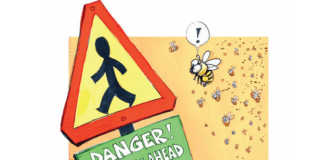
Let us be under no illusion about this: 2012 will be a year of action in agriculture, with an increased focus on food production. Since every grain producer in South Africa provides food for more than 6 000 of our citizens on average, Grain SA has an indispensable role to play.
The Department of Science and Technology (DST) takes the issue of food production, and grain production in particular, very seriously. We now have 10 research chairs in this field. In the City Press of 27 November 2011, last year’s World Food Prize Laureate, and former president of Ghana, John Kufuor, wrote, “Nothing better illustrates the crucial role that science must play in farming in Africa than the contrasts in agricultural productivity between our continent and the rest of the world.
Food productivity has increased globally by 140% in recent decades, but the figures for sub-Saharan Africa over the same period show a fall.” Kufuor goes on to say this discrepancy between Africa and the rest of the world shows how Africa’s agriculture has been cut off from the scientific advances that have transformed yields in other parts of the world. A third of the inhabitants of sub-Saharan Africa are chronically hungry – the highest percentage in the world.
Now that I’ve sketched this dark cloud, let me tell you about its silver lining. Unlike many other parts of the world, there’s a great deal of under-utilised land on the African continent, including a limited amount in South Africa, and there’s considerable potential to achieve productivity gains. It’s here that agricultural research has a vital role to play. And, of course, increasing yields and bringing new land into production will help address the challenge of achieving food security.
That is, “access to sufficient, nutritious and safe food at all times”, as the recently released draft National Development Plan has it.
Statistics suggest that, while too many households still have inadequate diets, there has, in fact, been a significant improvement in food security over the past decade. Now, with employment again on the increase, we expect a further decline in the number of ‘hungry households’.
Availability
Self-sufficiency in all commodities isn’t possible in most countries, and would not be a useful policy objective. Self-sufficiency in grain, especially grain that constitutes the staple diet of most people, is clearly desirable, but is not a prerequisite for food security. And, as we have learnt, surplus grain production does not automatically lead to a food-secure nation.
All the same, the availability of food in sufficient quantities is important – and if this flows from domestic production, so much the better. In general, it’s safe to say that this government’s economic policies, complemented by a social protection system, have ensured that increasing numbers of even the poorest households have the means to acquire enough food.
To improve availability, we as government propose to increase area of land under irrigation. This will lead to an increase in production, and also hopefully result in higher employment on farms. However, it needs the adoption of more efficient irrigation systems. A second measure to increase food production is improving the efficiency of all land reform projects.
Support of farmers in the former homelands, where the greatest poverty is still to be found, is equally important. This requires, among other things, more effective extension services and recapitalisation. Of course, it’s difficult for farmers to survive in the face of unfair competition from highly subsidised farmers in other parts of the world. And the government will continue to fight agricultural subsidies through the World Trade Organisation.
We note with appreciation the work done by Grain SA and other commodity organisations, such as those for sugar and wool, to help black farmers through training and mentorship. But an important question is whether we have appropriate technology to allow smaller farmers to compete in mainstream agriculture. The DST will soon be releasing a new bio-economy strategy, which emphasises the potential of biotechnology in support of agriculture and processing.
Without the responsible use of biotechnology, there’s little likelihood that the planet could sustainably feed itself. However, we should be mindful of the bitter historical irony of this sector, where a rapid rise in productivity led to the long-term decline in commodity prices, making it harder for farmers to survive. This is one of the main reasons that SA today has far fewer commercial farms now than 50 or even 20 years ago.
Thus, seeking greater food availability should not be done in such a way that it undermines farm profitability, leading to further job losses, while in any event not achieving long-term security of supply. Making farming more sustainable is no less important than making it more productive. One way of doing this is to promote conservation agriculture, and it’s encouraging to note the increase in research spending in this sphere in recent years. Conservation agriculture can also lower input costs, which makes farming more sustainable.
This brings us to two final points in the ‘availability’ part of the equation. Firstly, availability is not only about production, but about a country’s ability to import when necessary. Even with the best agricultural practices, grain depends on rain, and crop failure will occur. But it’s in our national interest to reduce our dependence on imports.
Secondly, the full range of food necessary for a healthy life must be available in Giyani as well as in Sandton. As we know, food prices in remote rural areas, where poverty is most acute, tend to be much higher than in the cities.
Affordability
While policies must address pricing, it is poverty that makes food unaffordable. The government believes growing the economy – and thereby creating jobs – is one of the best ways to address poverty and improve food security. We’ve already surpassed the UN millennium goal of halving the number of people living on or below US$1/day. We must now aim to reduce the number living on less than US$2/day.
Producing surpluses of staple foods, such as maize, is an effective means of ensuring the cheapest possible food. But if farmers are not making a profit, then the production system isn’t sustainable. The key question is what policies or interventions can help achieve not just surplus maize production, but profitable production, without direct subsidies (which are not sustainable).
The infrastructure investment programme announced by President Jacob Zuma in his State of the Nation address could lower the cost of doing business in the agriculture sector and make food more affordable, while boosting the share of the final shop price earned by farmers. The government has committed itself to upgrading infrastructure such as electricity, roads, rail and ports. Poor infrastructure, especially transport, contributes to high food prices.
Another contribution by government to lowering food costs has been the increased activity of the Competition Commission. A free market without competition is not the answer to affordable food. We have also taken note of the development of increased on-farm storage. This not only benefits national food security, but drives down the storage cost of grain.
Nutrition and food safety
I believe food safety and nutrition is an area that needs more attention. Partnerships between the DST and institutions such as the Maize Trust, the Winter Cereal Trust and others need to be established. I am looking forward to hearing the results of our combined efforts on mycotoxin research. The industry deserves praise for establishing a network of mycotoxin researchers and the international feedback is very encouraging.
Household food security
Our biggest challenge remains the eradication of hunger and malnutrition – or the attainment of ‘zero hunger’, as the department of agriculture has it. This is achievable not only through the measures mentioned already, but through the addition of other critical factors.
Household income is the most important of these. While it is not ideal to have 15 million people receiving grants, this intervention has rescued households from hunger. In the absence of secure permanent jobs, the Expanded Public Works Programme, and the Community Works Programme help secure income for households, while maintaining or expanding infrastructure.
We shouldn’t underestimate the importance of feeding schemes, such as soup kitchens, an essential interim solution. The school nutrition programme has been successful in ensuring that millions of children receive at least one nutritious meal a day. I believe there should be a massive expansion in local feeding schemes.
I’ve also taken note of the bursary schemes administrated by the grain and oil seed trusts. These are crucial in building capacity. In addition, the government has identified the increase of productivity in the communal areas as a strategy to improve household food security. This is a challenge where we need Grain SA’s support and advice in bringing this fallow land into production.
Finally, I would like to compliment Grain SA on its excellent work in supporting the development of black grain farmers, which it pursues with commitment and creativity. I believe Grain SA is setting an example which is raising the bar for how established agriculture can contribute to South Africa’s agrarian reform.
Adapted from the address given by Derek Hanekom, deputy minister of science and technology, at the opening of the recent Grain SA Congress.
The views expressed in our weekly opinion piece do not necessarily reflect those of Farmer’s Weekly.












